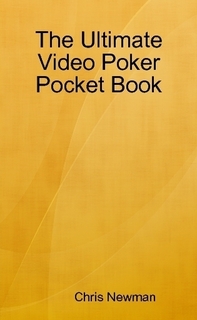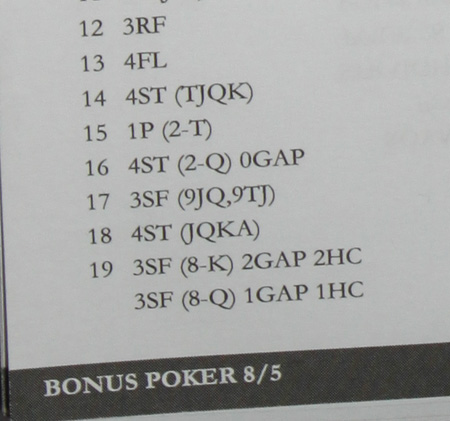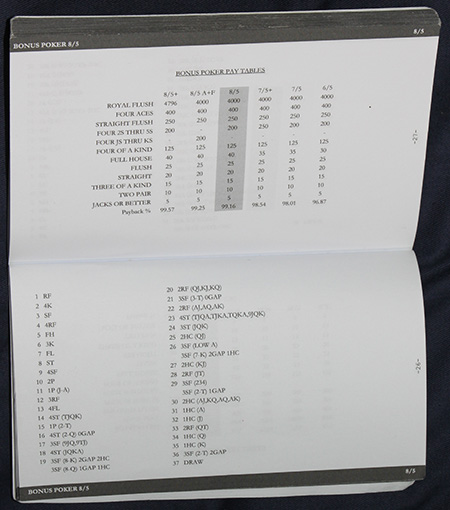I should probably admit that my "new book" is not actually that new any more. I had almost completely finished writing this one over a year ago.
Call me a perfectionist if you like, but I think procrastinator is probably more accurate.
I had to jump through a few hoops (and pretend to be American) to get an ISBN so that Amazon might list it, but when it came to it this week when I decided to finally publish the book there wasn’t much more I had to do than copy a chunk of text onto the copyright page and add a barcode to the back cover.
 So, before I have chance to put it off any longer, may I proudly present: The Ultimate Video Poker Pocket Book.
So, before I have chance to put it off any longer, may I proudly present: The Ultimate Video Poker Pocket Book.
It’s a grand title for something so small – and with such an unimaginative cover – I’m sure you’ll agree.
Furthermore, while I’m proudly trumpeting the arrival of a book I’ve written about video poker, it’s fairly easy to see that I’ve not actually had to write all that much at all myself.
In total, I wrote 10 (tiny) pages and I got a computer to create the rest. Although, to be fair, there was quite a bit of work involved in doing that, not least of which was teaching it how to typeset everything just the way I wanted.
The end result is, in my completely objective opinion, an essential collection of video poker strategy charts and pay table data, all compiled into one very handy, very compact little book – it’s about the same size as a postcard.
The idea of the book is that you don’t just have one basic strategy chart to take to the casino or for playing video poker online – you have lots of slightly different ones. Then, regardless of which game you decide to play and how the pay table is set, you can be sure that you’re playing optimally and making your money last as long as possible.
The concept evolved from an ever-growing stack of strategy cards I’d created for myself, held together in the corner with a split ring. Rather than just carry a general strategy for, say, Jacks or Better, I wanted to make sure I was playing correctly if I found a machine that offered a different payback to what I was used to.
For example, the Stratosphere casino used to have JoB with a 10/6 or 9/7 pay table, which is even better than the "full pay" 9/6 game I usually like to play.
In this notation, the first number represents the payout (as a multiple of your bet) for a full house and the second is the payout for a flush. On the 9/7 game, the value of flush draws (and straight flush and royal flush draws) goes up compared to 9/6. Whereas the 10/6 version has a meatier full house payout, meaning that pairs – and even just high cards – become more valuable compared to draws.
The optimal strategy doesn’t change wildly, but it does change. Although the 10/6 and 9/7 games had a positive expectation (and the casino advertised this fact loudly), to get the maximum payback it was necessary to adjust the way you play according to the pay table.
Sadly, these games died a death several years ago and never resurfaced. Their pay tables didn’t even make it into the book (I concentrated on profiling the most popular games that exist today) but the same principle applies to any situation.
If you usually play 9/6 Jacks or Better and know the strategy well, but one day the only game you can find is a 7/5 or 8/5 machine (typical on the Las Vegas Strip) you know the payout is going to be worse than you’re expecting – but it’s going to be worse still if you don’t adjust your strategy to account for the short-paying hands.
As the payback for the flush and full house gets smaller, the value of a straight draw increases. Not by enough to affect most decisions, but some marginal hands should be played in a different way.
For example, if you were dealt 99TQK, it would usually be correct to hold the pair over the straight draw, but with a 7/5 pay table the optimal play is to draw to the straight, or try to pair the queen or king to make a winning hand.
Well, in truth the optimal play is get up and find a better game than 7/5 JoB, but sometimes that’s just not an option.
How do we know this is right? Computer says so.
You’re just going to have to trust me on this, but the strategies have been thoroughly tried and tested on real games as well as on simulators that tell you when you’re making a mistake.
Heck, I’ve been using this book for 18 months and it’s prototype for years before that. If there were an error, I’d have found it by now.
Here’s how the book looks when you hold it open on a particular page. If you have really good eyesight (or just the initiative to click the image to enlarge it) you can have this strategy for free!
When held this way round, the upper page shows various pay tables for one type of game. In this case it’s Bonus Poker. One of the pay table variations is shaded and as you flick through the pages the shaded column moves. When you’re looking at a shaded pay table that’s the same as the one on the game you want to play, the strategy on the lower page in the book is the correct one to use.
The book also lists payback percentages, so you see how your chosen machine compares to pay table variations of the same game. This allows you to shop around and find the best games more easily.
Or if you already know which game you’re looking for, the shaded bar along the edge of each page contains that information and makes it easy to find.
If I may say so myself, it’s quite ingenious.
So, how do you read the strategy charts? The book explains in a bit more detail what all the abbreviations stand for (you can read the whole introduction in the preview, here), but once you see what’s going on it’s logical and quite straightforward. Here’s an example.
Suppose, when playing Bonus Poker with an 8/5 payable (corresponding to the picture above), you are dealt: 7s 8h 8c 9h Jh.
Your hand contains one pair, a four card straight draw with one gap and a three card straight flush draw with one gap. However, the draws each also contain a jack, which is considered a "high card" as this game pays out for pairs of jacks or better.
The relevant sections of the strategy chart are items 15 and 19, enlarged here:

Item 15 is "1P (2-T)", which means "one pair (as long as it is between twos and tens)".
Item 19 groups two similar types of hands into one item, and the second one is our draw. "3SF (8-Q) 1GAP 1HC" translates as: "A 3 card straight flush draw (having all cards between 8 and queen) with up to one gap allowed, but it must also contain at least one high card".
Once you know that SF is a straight flush draw and HC stands for "high cards", you can read the chart very quickly.
The hands are listed in order of their expected return, with the most valuable first. So the optimal play in any given situation is to hold the cards that correspond to the highest ranked (i.e. lowest numbered) item on the strategy chart that features in your hand.
So this tells us that your pair of 8s is a better hold than 8-9-J for a possible straight flush.
If a combination of cards isn’t on the chart, you don’t hold it. The inside straight draw (7-8-9-J) in your hand doesn’t make an appearance – it would be represented as "4ST 1GAP", or possibly "4ST 1GAP 1HC" if having the jack made a difference. It’s correct to hold an inside straight draw in some video poker games, but not this one.
The only other listed hand you have is "1HC (J)", which is way down the chart at number 32. The pair and straight flush draw are both better holds than just the single high card.
This may all sound a little dry and the book is certainly not going to be to everyone’s taste. It’s designed to be a useful companion, not something you’ll want to read cover-to-cover.
I’ve also realised from how long this post ended up being that it’s going to be quite a difficult sell. If you’re still with me this far, you probably deserve a medal. I need to work out how to explain what the book is all about (and why you need 80 different strategy charts in your life) in a couple of sentences!
But at least I’m using a publishing on demand service so if nobody buys it, I won’t have piles of the thing sitting around gathering dust…
You can buy The Ultimate Video Poker Pocket Book from lulu.com: 


I’m sure that reading it would probably be marginally more fun than playing the games.
The electronic version of my video poker book for iPhone and iPod Touch is now available for download on the App Store. For those that don’t have iTunes, or just can’t be bothered to click through, here’s a screenshot that really doesn’t tell you much a
[…] The best selling book in its class – fact! The Gambler’s Book Club wants to re-order supplies of The Ultimate Video Poker Pocket Book! […]